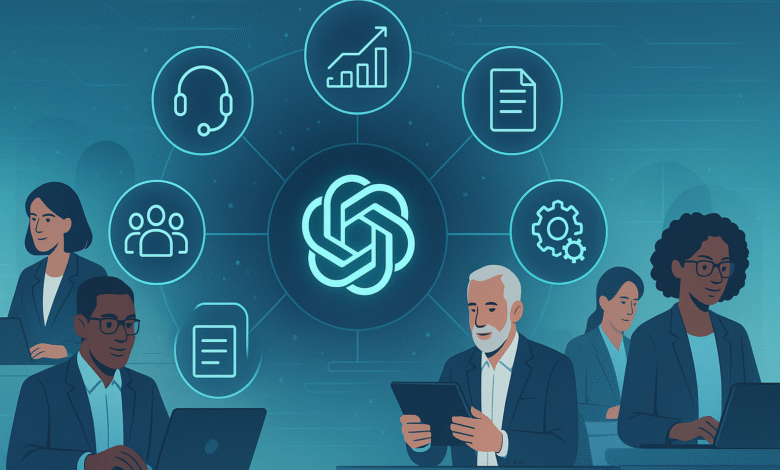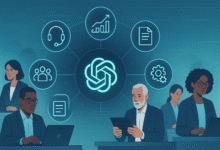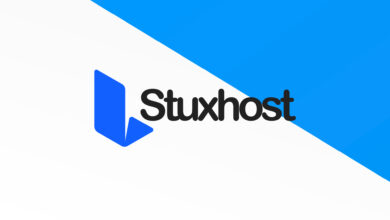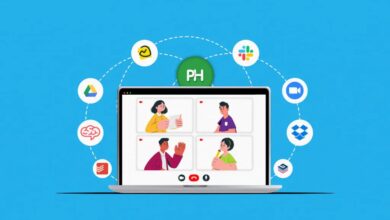
In today’s fast-paced digital landscape, ChatGPT for business has become far more than a novelty. What started as a conversation tool has evolved into a serious productivity engine that companies of all sizes are deploying across their operations. From Fortune 500 firms to scrappy startups, organizations are finding tangible ways to save time, reduce costs, and streamline workflows using ChatGPT business applications.
The practical reality is that ChatGPT helps businesses handle repetitive work, freeing employees to focus on strategy and creativity. Whether you’re in marketing, customer service, product development, or human resources, this AI-powered business solution is changing how teams operate daily. The question isn’t whether ChatGPT works for business anymore—it’s how to implement it effectively in your specific workflows.
This article dives into ten real, documented ways ChatGPT is transforming businesses right now. We’re not talking about theoretical possibilities or distant futures. These are concrete applications already delivering measurable results. We’ll walk through each use case, explain the practical implementation, and show you why business automation with ChatGPT is becoming essential in 2025 and beyond.
1. Automating Customer Support and Scaling Your Help Desk
ChatGPT for customer service has revolutionized how companies handle support tickets and inquiries. Instead of maintaining oversized customer support teams, businesses can now deploy AI-powered chatbots that handle initial customer interactions, answer frequently asked questions, and route complex issues to human agents.
The efficiency gains are substantial. According to research on ChatGPT business benefits, companies implementing AI chatbots for customer support have reported 40% lower response times and a 25% reduction in human support hours. These systems work 24/7 without breaks, providing round-the-clock support that would otherwise require multiple staff shifts.
Here’s how it works in practice:
- Customers ask questions through live chat or your support portal
- ChatGPT instantly provides relevant answers from your knowledge base
- Complex issues automatically escalate to the right team member
- Follow-up suggestions increase customer satisfaction and cross-selling opportunities
This isn’t replacing your support team—it’s giving them superpowers. Your experienced agents focus on nuanced issues requiring empathy and complex problem-solving, while ChatGPT handles the volume of routine inquiries that would otherwise bog them down.
2. Generating Content Faster Without Sacrificing Quality
ChatGPT for content creation is perhaps the most visible ChatGPT use case for business today. Marketing teams, product managers, and communication professionals are using this technology to accelerate content production while maintaining consistency.
The practical application varies by role:
- Marketing teams generate product descriptions, email campaigns, social media captions, and blog post outlines in minutes instead of hours
- Sales teams create personalized follow-up emails and proposal templates that feel natural rather than templated
- HR departments draft job descriptions and onboarding documentation without starting from scratch
- Product teams write technical documentation and user guides more efficiently
The key insight: ChatGPT works best as a first-draft engine. Your creative team provides direction, ChatGPT generates the foundation, and humans add polish, brand voice, and final approval. This collaborative approach actually elevates content quality while dramatically reducing creation time.
One ecommerce company automated product descriptions across hundreds of items, saving an estimated 500+ hours of manual writing while maintaining consistent tone and messaging.
3. Streamlining Business Automation and Routine Tasks
Business automation with ChatGPT goes beyond customer-facing interactions. Internal operations are transformed when repetitive administrative work gets delegated to AI.
Common ChatGPT business automation scenarios include:
- Meeting scheduling and coordination: No more back-and-forth emails finding available times
- Email triage and drafting: ChatGPT reads incoming messages, prioritizes urgent items, and drafts responses
- Data entry and form processing: Extracting information from documents and populating systems automatically
- Report generation: Summarizing data, creating executive-ready briefs, and highlighting key metrics
- Compliance documentation: Scanning documents against policy requirements and flagging issues
By automating these tasks, your team reclaims 5-10 hours per week per employee. That’s time freed up for strategic thinking, relationship building, and creative problem-solving—the work that actually moves businesses forward.
4. Enhancing Sales and Lead Qualification
ChatGPT helps businesses in sales by qualifying leads and personalizing outreach at scale. Rather than having sales reps manually evaluate every prospect, ChatGPT can analyze interactions and score potential customers.
The AI-powered business approach to sales automation includes:
- Lead qualification: Analyzing website behavior, chat interactions, and form submissions to identify high-potential prospects
- Cold outreach optimization: Drafting personalized initial contact messages that reference specific customer signals
- Sales email sequences: Creating targeted follow-up campaigns based on customer segment and behavior
- Proposal generation: Pulling templates and customizing them based on customer needs and industry
One digital marketing agency using ChatGPT for business automation in lead qualification saw a 35% improvement in conversion rates. By identifying and prioritizing the right leads, their sales team could focus energy where it mattered most.
5. Accelerating Product Development and Innovation
ChatGPT business applications extend into product teams managing complex development cycles. This is where ChatGPT’s business benefits become particularly valuable for managing ambiguity and generating options quickly.
AI-powered business innovation looks like this:
- Ideation and brainstorming: ChatGPT generates feature ideas, user story variations, and potential product angles
- Competitive analysis: Summarizing competitor features and identifying market gaps
- User feedback synthesis: Processing customer reviews and support tickets to surface common themes and pain points
- Technical documentation: Creating API docs, user guides, and troubleshooting materials
- Release notes and announcements: Turning technical changes into customer-friendly messaging
Product managers report that ChatGPT for business cuts research and documentation time roughly in half, allowing them to spend more time on strategy and validation rather than busywork.
6. Improving Marketing Strategy and Campaign Development
ChatGPT helps businesses in marketing by serving as a collaborative thinking partner, research assistant, and content factory rolled into one.
Marketing teams leverage ChatGPT business applications for:
- Campaign brainstorming: Generating multiple angles for messaging, headlines, and creative hooks
- Social media calendar planning: Outlining content themes and caption concepts for the month ahead
- Audience research: Summarizing industry trends and customer insights from market data
- A/B testing optimization: Creating multiple subject lines, calls-to-action, and messaging variations to test
- SEO and keyword strategy: Identifying content opportunities and optimizing for search intent
The result: marketing teams produce more creative output, test more variations, and make faster decisions. They’re no longer constrained by the time it takes to write—they’re constrained only by what they can test and analyze.
7. Automating Data Analysis and Business Intelligence
ChatGPT for business makes data analysis accessible to non-experts while accelerating the work of experienced analysts. This AI business solution democratizes insights across your organization.
Here’s where ChatGPT’s business applications shine in data and analytics:
- Spreadsheet analysis: Cleaning data, creating formulas, and generating charts without SQL expertise
- Executive summaries: Transforming raw data into narrative reports highlighting trends and recommendations
- Dashboard queries: Allowing team members to ask natural language questions instead of learning complex tools
- Anomaly detection: Identifying unusual patterns or outliers in performance data
- Forecasting: Running scenarios and projections based on historical data
A financial services firm using ChatGPT for business intelligence reduced the time spent on monthly reporting from two weeks to three days, while actually improving report quality and relevance.
8. Supporting HR and Talent Management
ChatGPT business applications dramatically simplify HR workflows that typically consume enormous amounts of administrative time. This AI-powered business approach transforms everything from recruitment to onboarding.
ChatGPT helps HR teams with:
- Job description writing: Creating detailed, SEO-optimized postings that attract the right candidates
- Interview preparation: Drafting candidate evaluation rubrics and interview question frameworks
- Employee onboarding: Generating training materials and answering new hire questions about policies and procedures
- Performance documentation: Drafting performance review language that’s fair, specific, and constructive
- Leave and benefits: Responding to routine HR questions about policy instantly
The ChatGPT business benefit here is freeing HR professionals from administrative work so they can focus on culture, development, and strategic talent planning. One mid-sized company reduced the time HR spent answering repetitive policy questions by 60% after implementing ChatGPT.
9. Enhancing Training and Knowledge Management
ChatGPT for business serves as an on-demand training assistant and corporate knowledge base. This addresses a real pain point: employees wasting hours searching for information instead of accessing it instantly.
AI business solutions for training include:
- Learning module creation: Generating training content for new software, processes, or product updates
- Question answering: Providing instant responses to employee questions about company policies, product specs, or procedures
- Knowledge base improvement: Identifying gaps in documentation and suggesting content improvements
- Personalized learning paths: Recommending training based on employee role and skill gaps
- Multilingual support: Translating training materials for distributed teams
A software company using ChatGPT for knowledge management saw new employee ramp-up time decrease by 30%. Instead of drowning new hires in documentation and Slack messages, they had instant access to answers.
10. Streamlining Legal and Compliance Work
ChatGPT helps businesses navigate the complex, documentation-heavy world of legal and compliance work. This isn’t replacing lawyers—it’s handling the prep work that consumes their time.
ChatGPT business applications in legal and compliance:
- Contract analysis: Summarizing key terms, highlighting unusual clauses, and identifying potential risks
- Compliance checklists: Creating task lists for regulatory requirements (GDPR, HIPAA, California Consumer Privacy Act)
- Document review: Scanning contracts and policies against compliance standards and flagging issues
- Training material: Creating compliance training for employees that’s actually comprehensible
- Audit preparation: Organizing documentation and summarizing processes for compliance audits
One mid-market company reduced the time spent on compliance documentation prep by 40% using ChatGPT for business. Their legal team focused on decision-making while ChatGPT handled information gathering and organization.
Getting Started with ChatGPT for Your Business
The gap between understanding ChatGPT’s business benefits and actually implementing it isn’t huge, but it requires a clear approach. Most successful companies follow a simple framework:
- Identify repetitive, text-heavy processes in your business where humans spend time but don’t add unique value
- Start with low-risk pilots in one department rather than attempting organization-wide rollout
- Measure the right metrics: time saved, quality maintained, costs reduced, customer satisfaction improvements
- Gather feedback from actual users and refine your approach based on what works in your specific context
- Train your team on effective prompting rather than assuming ChatGPT outputs are production-ready
For more guidance on implementation, check out OpenAI’s guide to identifying and scaling AI use cases, which provides frameworks used by Enterprise customers.
Best Practices for AI Integration
When deploying ChatGPT for business automation, these practices separate successful implementations from disappointing ones:
- Maintain human oversight: Use ChatGPT as a business tool to augment teams, not replace them. Complex decisions, nuance, and anything requiring judgment should remain with humans
- Protect sensitive data: Keep confidential information out of standard ChatGPT unless you’re using enterprise-grade deployments with data privacy guarantees
- Review and refine regularly: Your prompts and processes will improve with use. Build in monthly reviews to optimize what’s working
- Combine with other tools: ChatGPT business applications work best integrated with your existing systems—CRM, project management, analytics—rather than used in isolation
For deeper technical guidance on implementation, TechTarget’s guide to realistic business use cases offers realistic expectations and common pitfalls to avoid.
Conclusion
ChatGPT is helping businesses solve real problems in real time, from automating routine work to accelerating strategic initiatives. The ten ChatGPT business applications outlined here aren’t hypothetical—they’re happening across industries today, delivering measurable productivity gains and cost savings.
Whether you’re focused on ChatGPT for customer service, business automation, content creation, or data analysis, the core benefit remains consistent: more time for meaningful work and faster execution of important projects.
The companies winning in 2025 aren’t those debating whether to adopt AI-powered business solutions; they’re the ones who’ve moved past the hype and integrated ChatGPT into their daily workflows strategically and thoughtfully. The competitive advantage goes to organizations that start experimenting now, learn from pilots, and scale what works.











